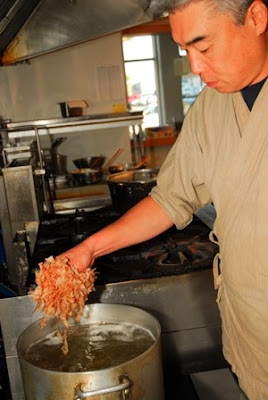
The term "locavore" took just 3 years to find it's way into the Oxford American Dictionary. But not just as another new word, as...yup..."Word of the Year".
As with so many things, it started in California. First coined by a group of San Francisco area women, "locavore" has become a favourite term for foodies and farmers alike. A 2010 survey of Canadian Chefs revealed that the top three "menu trends" are:
1) Locally sourced food
2)Sustainably produced ingredients
3)Organic produce
Trends to be sure, but will they last? Everyone wants to talk about eating locally produced, sustainably-sourced meals, but are people buying in? In a volatile economy, are they willing to pay for it? Organic, sustainable and local almost always carries a higher price tag than mass produced McFood.

At Sanbiki and Mori Mori, many customers are interested in local and sustainably sourced ingredients. They like seeing the Oceanwise symbol on our menu (and wall) and know that our tuna and salmon are from well-managed West Coast fisheries. Come spring, customers and downtown Chefs alike can be spotted shopping the Farmers Market. What else is going on in and around Kamloops?

Masato recently joined the TSCFC. It stands for "Thompson Shuswap Chef Farmer Collaborative. Aimed at bringing Kamloops and area Chefs together with local producers, the collaborative is still new but gaining momentum. In the photo above, TRU Culinary Arts Instructer Ed Walker outlines some of TSCFC's objectives. Cards, emails and ideas were exchanged by producers, Chefs and restaurateurs.

Masato recently joined the TSCFC. It stands for "Thompson Shuswap Chef Farmer Collaborative. Aimed at bringing Kamloops and area Chefs together with local producers, the collaborative is still new but gaining momentum. In the photo above, TRU Culinary Arts Instructer Ed Walker outlines some of TSCFC's objectives. Cards, emails and ideas were exchanged by producers, Chefs and restaurateurs.

"Ted's Trout" are based in Little Fort and raise rainbow trout. They are proof that aquaculture can provide an environmentally sound, local and delicious alternative to fish taken by factory trawlers, or farmed in open sea pens. Maureen and Ted visited Sanbiki last week after meeting Masato at the TSCFC meeting. They dropped off some smoked and fresh frozen trout samples. These are products we want to start selling to our grocery customers next door at Mori Mori.

While local food is good; local booze...well, that's even better! We have seen an excellent response to Crannog Ales and the now famous (infamous!) Party Pig. There are no bottles or cans to recycle and their handcrafted organic Ales are brewed just down the road in Sorrento.

Premium, chilled sakes from Granville Island's Masa Shiroki are catching on too. Last year Shiroki-san experimented with growing sake rice in the Kamloops area. Apparently the birds got most of it but he hasn't given up yet...


That's all for now. We at Sanbiki are seriously ready for spring! Patio planning has begun already...trying to remember what flowers survived my care last season...there weren't many!!























